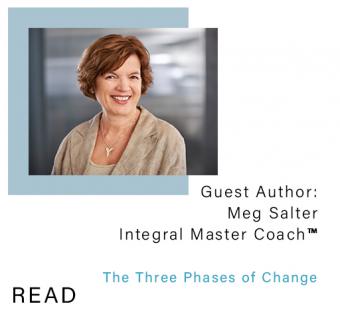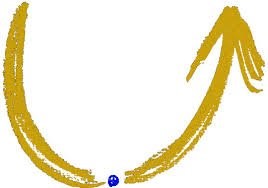Blog

“I've rarely experienced a 'training' program that so effectively combines rigorous methodology with generous heart. I now have a living compendium of precise, relevant practices.”
“Working with Joanne and Laura has been transformational at many levels of my life. Through their Integral Coaching® training, I have come to understand what “being human” means.”
“Integral Coaching Canada provides what we believe is the most complete and comprehensive coaching program available. ”

What Phase of Change Are You In?
When you’re in a period of transition, it feels exquisitely personal. Yet, while the content of what is changing in your life is unique to you, the process of how change occurs follows a universal pattern. Knowing where you are in this cycle of change can help you orient yourself now and navigate your way forward with greater ease, less stress—and maybe even more speed!
Integral Coaching Canada uses Otto Scharmer’s U curve as one model that can be used as a way to understand the fundamental process of personal change. I have found this model incredibly helpful both to help my Executive Coaching clients move forward in their coaching topic, and to help Mindfulness Coaching clients determine suitable practices. (My book Mind Your Life includes a variety of mindfulness practises linked to the phases of change.)
Several statements clients have made to me remind me of the basic phases of change:
- I can’t believe I do that! Every time I go to a meeting, I can see what needs to get done. So, I roll up my sleeves, take charge and we get it done. I almost never ask probing questions. How did I not see that?
- I’m feeling a great sense of disorientation. Almost like I don’t know myself anymore. I’m doing lots of activities, but none of them are satisfying. I can’t believe I’m at this age and not yet sure of what I want to do. It’s kind of sad.
- I’ve just started this new dream job, and while I would never go back to my old life, I wonder sometimes, “What have I done? How am I going to make this work and still see my family?”
-
As a meditator, I have always valued letting-go, shedding attachments, and the place of stillness where we can experience oneness. I trusted that if we do these, then no further self-effort was necessary. But as you point out, we are embodied beings, and the intentions we bring to our embodiment are present whether we are conscious of them or not.

Three Phases of Change
Knowing and trusting the process of personal change helps develop resilience (see this Integral Coaching Canada post). The process has three broad phases: letting go of the old, allowing a gap of transition, and letting come something new.
For much of our lives, we are not in transition. This is a good thing, transition can be exhausting! We are more often in performance mode, with our behaviour and thinking operating through well-honed grooves of habit. We are reasonably effective in our lives. Our habit patterns serve us well, so we don’t have to think too much about them. We are operating on autopilot.
Then some kind of setback, challenge, or trauma occurs. We respond in our usual ways but find they don’t work very well anymore. This precipitates the upper left side and downward slope of the U curve. This is where people often seek coaching.
Letting Go Phase
The left side of the curve is the “Letting Go” phase of change. It is all about unlearning old habits and dis-identifying from your old sense of self. You start the process by hitting the pause button, in effect suspending your automatic ways of being and doing. You redirect awareness to observe yourself and your situation more deeply. You start to become conscious of things you did unconsciously. You can look at what you used to look through. When you are able to do this thoroughly you can let go of the old (see more about developing self-awareness here). My client statements #1 and #2 illustrate this phase.
Gap of Transition Phase
You do not immediately jump into the new, even though you may want to. The bottom of the U curve is the “Gap of Transition.” It is an awkward in-between zone; the gap between your old self and your new self, where you are neither one thing nor another. The bottom of the U is a place of questions, but not yet answers, where you rest in the unknown. The more you have let go of old patterns, the more you’re able to see with fresh new eyes. Eventually, you detect the glimmering of new answers to your questions, which precipitates the right-hand, upward sloping side of the U curve. The unknown is the place where possibility exists; the only place from which you can truly create the new. Client statements #2 and #3 illustrate this phase.
Letting Come Phase
The right-hand side of the U is about “Letting Come” and the emergence of something fresh and new. You construct a newer identity, you figure out more effective ways of doing and being that respond to deeper yearnings. Because you have let go of old ways, you are able to let come something that is truly innovative. You are able to tap into a creativity you may not have suspected. When you are able to embody these new ways in a consistent way, you have a new set of habits, more effective and personally fulfilling than before. You have enacted the new. Client statement #4 above is an example of someone newly appreciating the value of this phase of change.
Try This for Yourself
If you’re in the Letting Go Phase:
- Create spaces to listen deeply, to yourself and others.
- Suspend your usual judgments; what if they no longer apply?
- Become aware of what used to give you satisfaction but is now humdrum.
- Ask others what your blind spots are.
- Sense more deeply into what is yearning to be born, or deeply needed—by you, by others and by the situation around you.
- Meditation practices can be more directed and observational. For example: Focus Out[1] to ground yourself in the natural world, or Focus In to witness your inner monologues and emotional states.
If you’re in the Gap of Transition Phase:
- Expect to be disoriented and confused with no immediate answers.
- Recall other big transitions periods in your life. What got you through then?
- Meditation practices can be very broad and receptive. For example: Focus On Rest, open focus, choiceless awareness. Let signals come to you.
If you’re in the Letting Come Phase:
- Try out new moves in tentative, low-risk, “pilot project” ways.
- Learn by doing. Make mistakes and fail fast.
- If you don’t know what you want longer term, be clear on what you don’t want.
- Meditation practices can intentionally nurture what you wish to create. For example: visualizations, loving-kindness, or re-framing affirmations.
Over the long term, our lives are a continuous process of periods of stability, punctuated by times of transformation and renewal. A reliable map like the U curve three phases of change can guide you toward the support you need, the perspective to adopt and the relevant actions to take. Enjoy!
[1] Focus Out, Focus In and Focus on Rest are meditation practices. Detailed instructions are in my book Mind Your Life, or you can find a general orientation in Shinzen Young’s “See Hear Feel: An Introduction, starting on page 52.










